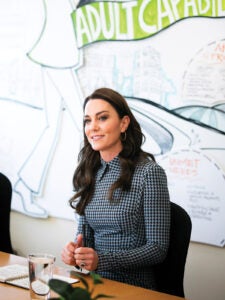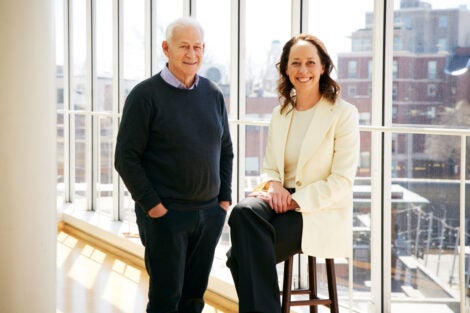Harvard’s Center on the Developing Child has illuminated the ways that early influences shape us for life. Now, it’s launching new efforts aimed at giving every child an equal chance at a healthy start.
May 26, 2023—From the womb to their third birthday, young children’s tiny bodies and brains are astonishingly malleable. As children take in floods of input from their surroundings, their brains and immune and metabolic systems adapt to prepare them for the world they’ve been born into. And the contours of that world—be they supportive or threatening—can have lifelong implications for health and well-being.
As affiliated faculty at Harvard’s Center on the Developing Child explain it, young kids are forming biological foundations that will serve them for the rest of their lives. The resilience of these foundations depends on whether children are provided with the essential tools that form sturdy support beams, like responsive interactions with caregivers, nutritious food, and safe places to play. If instead they encounter prolonged stress, neglect, or violence, they are more likely to be vulnerable to later stressors and harmful exposures throughout their lives, increasing their risk of poor outcomes in learning and health.
“It’s never too late to make things better, but in the long run, you’re always better off by having the best health-promoting experiences as early as possible,” says Jack Shonkoff, director of the Center and Julius B. Richmond FAMRI Professor of Child Health and Development at Harvard T.H. Chan School of Public Health and Harvard Graduate School of Education, and professor of pediatrics at Harvard Medical School and Boston Children’s Hospital.
Since Shonkoff launched the Center in 2006, he and his colleagues have played a key role in establishing their field’s scientific base, first focusing on the brain and then on the rest of the body. As it has become clear just how much early influences affect us for life, identifying policy implications across wide swaths of society, from environmental health to city planning, has become more urgent. The next phase of the Center’s work will focus on putting ideas into action.
Beyond “do-goodism”
Shonkoff traces the start of the modern early childhood development field to the 1960s, when Head Start and other programs in the Johnson administration’s Great Society and War on Poverty agendas tried to level the playing field for kids born into poverty. Around that time, developmental psychology was moving toward the idea that a child’s IQ was shaped by both environment and genetics. Government programs focused on school readiness, providing early education opportunities, and training for caregivers. If the programs did touch on health, Shonkoff says, it was limited to time-honored basics like access to health and dental care, vaccinations, and growth milestones.
When he started his medical training in the 1970s, Shonkoff says he chose pediatrics because he was “obsessed with inequalities and injustice.” When he began working in a community health center as a resident at Bronx Municipal Hospital Center, it became clear that the threats to children’s health were not just medical and were more extensive than he—or any doctor—could treat. He spent the next 15 years of his career as a fellow and then assistant in medicine at Harvard Medical School and Boston Children’s Hospital and later a faculty member at UMass Medical School, where he was chief of the Division of Developmental and Behavioral Pediatrics and increasingly engaged in policy focused on young children with disabilities.
In the late 1990s, Shonkoff was appointed chair of the National Academy of Sciences’ Board on Children, Youth, and Families. He struggled with the siloed nature of early childhood services, as child welfare, child care, and primary health care each had its own knowledge base and training programs. Then one day, he says, “It was like a light bulb went off in my head: They all rested on the same underlying science.”
He proposed an NAS study committee to do a deep dive into multiple contributing disciplines and identify the integrated science of early childhood development. It was funded in 1997 with Shonkoff as chair and in 2000 produced the landmark report From Neurons to Neighborhoods: The Science of Early Childhood Development. “That report put an important stake in the ground,” says Shonkoff. “It showed that the early childhood field isn’t simply about do-goodism; it’s grounded in rigorous science.”
Although the National Academy did not have a mechanism for continuing activity after a report was released, Shonkoff strove to build an action agenda. With initial support from the MacArthur Foundation, he founded an independent, multidisciplinary, multi-university collaboration called the National Scientific Council on the Developing Child (NSCDC) in 2003, which he still chairs. He was then also serving as dean of the Heller School for Social Policy and Management at Brandeis University, but in 2005 decided to step down from that position. Around that time, he received a fortuitous phone call from Harvard School of Public Health Dean Barry Bloom and Julius Richmond—first director of the federal Head Start program, former U.S. surgeon general, and a professor with multiple Harvard appointments—to ask if Shonkoff would be interested in coming to Harvard to launch an interfaculty initiative on children.
Soon after, in 2006, Shonkoff started the Center on the Developing Child with, as he puts it, “no website, a staff of three, and a lot of ambition.” Since then, the Center has built a global reputation as a trusted, nonpartisan voice for science-informed policy, and a place where affiliated faculty can engage in collaborative work.
From the brain to the body
In its early years, the NSCDC produced a core story of the science of early brain development, which the Center now refers to as ECD 1.0. This included using terms such as “serve and return interaction” to describe the mutually responsive caregiving that shapes healthy neural connections in early life, and “toxic stress,” which was coined to explain how extreme conditions of chronic neglect or overt abuse can lead to extensive disruptions of multiple developing systems (neural, immune, metabolic) and greater risk of lifelong problems in development and health.
More recently, advances in science have deepened understanding of the highly interrelated ways in which personal experiences and broader environmental influences are embedded biologically. This expanded view was laid out in a report released by the Center last year which introduced ECD 2.0.
A working paper published in March, “Place Matters: The Environment We Create Shapes the Foundations of Healthy Development,” advances that work. It describes the powerful effects natural and built environments have on children’s health and development and issues a call to action for “fairness of place,” meaning that communities, businesses, and governments need to work together to ensure supportive and healthy environments for all children. Noting that hazards and opportunities are not distributed equally, the authors write that society must confront systemic racism and other structural inequities that lead to preventable disparities in child development and lifelong physical and mental health.
“As a society, we’re not doing enough for kids who are facing significant adversity, and that’s not ok. That’s the problem that keeps me going.”
—Lindsey Burghardt
Lindsey Burghardt, MPH ’15, is chief science officer at the Center and a co-author of the new report. A big part of her job involves connecting the dots between harmful exposures and poor outcomes for children in a way that will be helpful for policymakers. “At the Center, what we do is find the compelling story in what the science is telling us,” she says.
Burghardt is a pediatrician who currently splits her time between her private practice and work at the Center. During her fellowship in pediatric emergency medicine at Boston Children’s Hospital, she was mentored by Harvard Chan School alumna Florence Bourgeois, MPH ’05, who encouraged her to think bigger and start looking at systemic problems in children’s health. This advice led Burghardt to enroll at the School, where she took transformative classes with Ichiro Kawachi, John L. Loeb and Frances Lehman Loeb Professor of Social Epidemiology, who first opened her eyes to the connection between neighborhoods and health, and with Shonkoff, who taught her about the developing brain.
She’d recently given birth to her third child and recalls thinking, “I don’t know this stuff and I’m a pediatrician. Who else doesn’t know about this?” She was struck by the idea that research and policy could provide a way to improve kids’ health on a larger scale, and it shifted her career goals in a new direction. A conversation with Barry Dorn, a lecturer in the Department of Health Policy and Management, sealed the deal.
“He encouraged me to always keep in mind the thing I found most unacceptable,” Burghardt says. For her, it would always come back to kids and inequity.
She left emergency medicine and moved into private practice, and then started working with the Center during the pandemic. “Now, I’m able to work on finding ways to help kids facing adversity, so I feel like this is the best job I could ever have,” she says.
Burghardt recently formed a new Center task force called the Early Childhood Scientific Council on Equity in the Environment. It brings together researchers with a range of expertise to address issues raised in the “Place Matters” report, including Harvard Chan School faculty members Kari Nadeau and Natalie Slopen, who focus on the health effects of climate change and structural racism, respectively. Their agenda this summer will be to distill the report into a short list of policy priorities and to work on honing their message for policymakers and the public.
A royal visit

The Center also hopes to make an impact through its collaboration with an unexpected source—the U.K.’s Royal Foundation. The foundation’s Centre for Early Childhood was launched by Catherine, Princess of Wales, in 2021. Harvard’s Center provided scientific support to the report released in conjunction with the launch of the foundation’s center. Last December, the princess visited the Harvard Center while in Boston with Prince William to present an environmental prize.
Burghardt was one of the staff members who participated in a meeting during the visit and says she and others came away impressed by the princess’s deep understanding of the science of early childhood development. “She was really interested in hearing from all of us, and asked poignant questions,” Burghardt says. “You could tell that she cared deeply on a personal level, like we all do.”
The Center hopes increased attention from the princess’s visit and further collaborations with the Royal Foundation will shine a global light on the value of science-informed policy in the early childhood period.
As Shonkoff sees it, “The alignment of science with lived experience should be driving new ideas. Early childhood policy can’t just be seen as education policy, or as health policy alone. It also has to be part of environmental policy, housing policy—areas where policymakers wouldn’t have previously thought about bringing in an early childhood lens. We have to be thinking about how to achieve greater impact on a global scale.”
Photos: Kent Dayton (Shonkoff and Burghardt); Stephanie Mitchell / Harvard University (Princess Catherine)
